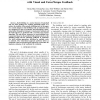Free Online Productivity Tools
i2Speak
i2Symbol
i2OCR
iTex2Img
iWeb2Print
iWeb2Shot
i2Type
iPdf2Split
iPdf2Merge
i2Bopomofo
i2Arabic
i2Style
i2Image
i2PDF
iLatex2Rtf
Sci2ools
106
click to vote
ICRA
2009
IEEE
2009
IEEE
Robot basketball: A comparison of ball dribbling with visual and force/torque feedback
Ball dribbling is a central element of basketball and one main challenge for realizing basketball robots is to achieve the stability of the periodic dribbling task. In this paper two control designs for ball dribbling with an industrial robot are compared. For the two strategies, the ball position is determined either through force/torque or visual sensor feedback and the ball trajectory is predicted with a recursive least squares algorithm. The end effector trajectory for each dribbling cycle is generated based on the predicted ball position/velocity at the dribbling height and the estimated coefficient of restitution. For both tracking approaches, dribbling for multiple cycles is achieved. The vision-based approach performs better as compared to the force/torque-based approach, in particular for imprecise estimates of the coefficient of restitution.
Ball | Dribbling | ICRA 2009 | Periodic Dribbling Task | Robotics |
| Added | 19 Feb 2011 |
| Updated | 19 Feb 2011 |
| Type | Journal |
| Year | 2009 |
| Where | ICRA |
| Authors | Georg Batz, Kwang-Kyu Lee, Dirk Wollherr, Martin Buss |
Comments (0)

